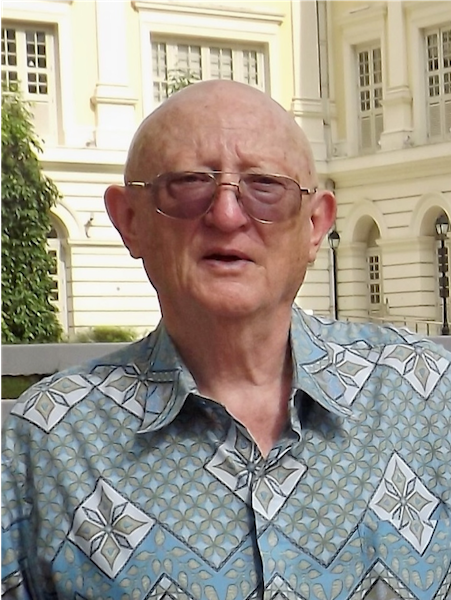Jubilee Fellow – 2015

Emeritus Professor Alan Powell AM
BScAgr, PhD (Sydney), DEcon (Honoris Causa) (Monash)
2015 Reflections
I came into economics after completing an agricultural science degree. In 1968 Max Corden noted that most Australian agricultural economists had been trained in the US, where an econometric approach was the rule [1]. This was in contra-distinction to economists trained in Britain at that time. In the 1960s and ‘70s several agricultural economists, including Ross Parish and Fred Gruen, moved into broadly defined economic policy.
When my PhD at Sydney under K. O. (Keith) Campbell was nearing completion in 1961, John Dillon urged me to apply for a lectureship at the University of Adelaide, where the Department of Economics was very strong. This enabled me to get to know several members who would within a year or two hold chairs in Australia (among others, Dillon, Brunt, Hancock and Harcourt). Dillon further encouraged me to apply for Chicago’s Postdoctoral Fellowship in Political Economy: to my amazement this was successful. There I was exposed during 1964 to such intellectual giants as Theodore Schultz, Harry Johnson, Arnold Zellner, Jacquez Drèze, Milton Friedman and Hans Theil.
Teaching econometrics at Monash kept me busy during 1965-74. During September 1971 – January 1973 I was on sabbatical and extended leave at the Development Research Center of the World Bank[2]. While in Washington I was approached by Bill Carmichael of the Industries Assistance Commission (IAC) with the offer of a job leading a team that would build policy-analytical tools which could inject some discipline and objectivity into trade policy advice. This was enthusiastically supported by the IAC’s chairman, Alf Rattigan[3], and led to the establishment of the IMPACT Project, housed initially adjacent to the IAC’s Melbourne office, and later at the University of Melbourne, where I held the Ritchie chair from 1979-91[4]. From the start IMPACT adopted an economy-wide focus, with sub-models covering the economy’s detailed industry structure, labour force and demography[5].
While in Washington I met up again with my former honours student, Peter Dixon, who was working at the IMF. A few years later it was my tremendous good fortune to be able to recruit him to build IMPACT’s detailed economy-wide model. Dixon realized that Johansen’s approach[1], which expressed a model’s equations as percentage changes in variables, gave a clearer expression of its economics, and could be solved (at least approximately) as a set of linear equations. He recruited Brian Parmenter and John Sutton as the critical members of his team, the latter writing model-specific computer code[2] to solve the Orani model[3],[4],[5]. Orani and its successors (Monash[6] for Australia and Usage[7],[8] for the US) became available to policy advisers in a huge variety of applications[9]. The task of building (and maintaining) a computer language and solver which could be used by anyone with a data base and the ability to write down their equations was remorselessly and brilliantly undertaken by Ken Pearson: sadly, we lost him to cancer last May. This role is now in the hands of Mark Horridge who had collaborated with Ken over many years in the development of Gempack, producing Windows “apps” which facilitated understanding and explaining the results of policy and forecasting simulations with GE models.[10]
The international use of Gempack expanded greatly with the development of GTAP (the Global Trade Analysis Project) for modelling trade (and other issues) on a global basis. GTAP was the initiative of Tom Hertel[11], a Professor and Senior Fulbright Fellow from Purdue University who spent a year (during 1990-91) with the IMPACT group in Melbourne. He later described GTAP as “taking IMPACT abroad.”[12] Apart from universities, the GTAP data base and models in the GTAP family are now used by a very large number of international and national policy agencies.
How did my initial training in physical sciences affect the input that I could make to the policy-advising infrastructure? First and foremost, all aspects of policy tools (models, data, details of simulation results) should be in the public domain, so that all policy suggestions coming from them could be understood, checked and replicated by independent critics. This would not have been possible without extensive public documentation and the tools available in Gempack which enable executable versions of models to be transmitted seamlessly among different researchers. These ideas were not at first accepted by policy bureaucrats. Details of their gradual acceptance will be found in papers by Powell, Lawson, Snape and Dee[13].
From the above you will see my tremendous luck in having been so well treated by so many highly talented people. I feel sad that within the confines of 750 words I have not been able even to mention many of their names.
[1] M. W. Corden, “Australian Economic Policy Discussion in the Post-War Period: A Survey”, Surveys of National Economic Policy Issues and Policy Research, Supplement, American Economic Review, 58 (3) Part 2, June 1968, pp. 88-138.
[2] At the Bank I worked with Constantino Lluch, who, with Ross Williams and myself, produced a study of changes in consumer demand patterns as countries moved through the development spectrum: see Constantino Lluch, Alan A. Powell and Ross A. Williams, Patterns in Household Demand and Saving (Oxford University Press for the World Bank, 1977).
[3] See Farquharson’s excellent obituary, http://oa.anu.edu.au/obituary/rattigan-godfrey-alfred-alf-839/text840.
[4] I moved back to Monash in October 1991 to a personal chair in econometrics. My teaching commitments there involved macro-economic modelling. Together with Chris Murphy I documented his Murphy Model (Alan A. Powell and Christopher W. Murphy, Inside a Modern Macroeconometric Model – A guide to the Murphy Model, Springer Lecture Notes in Economics and Mathematical Systems No 428, Berlin 1995). Because the Orani model (as documented below in footnotes 8 and 9) was agnostic about the short-term macroeconomy, and so required the user to set some variables exogenously, it seemed worthwhile to try instead to use a (dynamic) macroeconometric model which would endogenize most of the missing information in the (comparative static) GE model. The most ambitious form of this tactic required a chosen macro model (in this case, the Murphy Model) to be interfaced with Orani. This required novel advanced theory supplied by Keith R. McLaren and Russel J. Cooper – see their “The ORANI-MACRO Interface: An Illustrative Exposition”, Economic Record, vol 59 no 165 pp.166-179 (1983) and Russel J. Cooper, Keith R. McLaren and Alan A. Powell , “An Approach to the Short Run Macroeconomic Closure of General Equilibrium Models”, in J. Piggott and J. Whalley (eds), New Developments in Applied General Equilibrium, pp. 411-40, Cambridge University Press, New York 1985.
[5] The first of these took inspiration from David Evans’ book [H. David Evans, A General Equilibrium Analysis of Protection in Australia (Amsterdam: North-Holland, 1972)] documenting his Harvard PhD which used the mathematical programming approach: this was right at the frontier of computational feasibility at the time.
[6] Leif Johansen, A Multisectoral Study of Economic Growth, North-Holland Contributions to Economic Analysis number 21, Amsterdam 1960.
[7] Using this to solve Orani needed a dedicated land line to Canberra which had one of the few computers big and fast enough for the job. Fortunately, the need of policy advisers for finer detail, and the power and speed of computers, increased more or less hand-in-hand.
[8] Peter B. Dixon, Brian R. Parmenter, George J. Ryland and John M. Sutton, Orani, A General Equilibrium Model of the Australian Economy: Current Specification and Illustrations of Use for Policy Analysis, First Progress Report of the Impact Project, Vol 2, Australian Government Publishing Service, Canberra 1977.
[9] Peter B. Dixon, Brian R. Parmenter, John M Sutton and David P Vincent, Orani, A Multisectoral Model of the Australian Economy, North-Holland Contributions to Economic Analysis number 142, Amsterdam 1982.
[10] Dixon realized that the approximate solutions obtained using Johansen’ method could be refined with straight-forward iterative techniques (see chapter 2, section 8 of the reference immediately above).
[11] Peter B. Dixon and Maureen T. Rimmer, Dynamic General Equilibrium Modelling for Forecasting and Policy: A Practical Guide and Documentation of Monash, North-Holland Contributions to Economic Analysis number 256, Amsterdam 2002.
[12] Peter B. Dixon and Maureen T. Rimmer, “The US economy from 1992 to 1998: Results from a Detailed CGE model”, Economic Record 80 (special issue), S13-S23, 2004.
[13] Peter B. Dixon, Robert B. Koopman and Maureen T. Rimmer, “The Monash Style of Computable General Equilibrium Modelling: A framework for Practical Policy Analysis”, chapter 2, pp. 23-103 in volume 1A of Peter B. Dixon and Dale W. Jorgenson (eds), Handbook of Computable General Equilibrium Modeling, North-Holland, Amsterdam 2013.
[14] Dixon and Rimmer (p. 26 of the reference immediately above) mention that the adaptability of the models in the Monash family “have provided insights … on the effects on: macro, industry, regional, labor market, distributional and environmental variables of: changes in taxes, public consumption, social-security payments, environmental policies, technologies, international commodity prices, interest rates, wage-setting arrangements and union behaviour, infrastructure and major-project expenditures, and known levels and exploitability of mineral deposits (the Dutch disease)”.
[15] Gempack is now used widely around the world in universities and government agencies.
[16] Thomas W. Hertel (ed), Global Trade Analysis — Modeling and Applications, Cambridge University Press, 1997. Hertel reviews the current state of GTAP in “Global Applied General Equilibrium Analysis using the Global Trade Analysis Project Framework”, chapter 12, vol 1B of Peter B. Dixon and Dale W. Jorgenson (eds), Handbook of Computable General Equilibrium Modeling, pp 815-867, North-Holland, Amsterdam 2013.
[17] Thomas W. Hertel, ”Taking IMPACT Abroad: The Global Trade Analysis Project”, paper presented at the IFAC Workshop on Computing and Finance”, Amsterdam June 8-10, 1994.
[18] Alan A. Powell , foreword to Hertel op. cit.; Alan A. Powell and Tony Lawson, “A Decade of Applied General Equilibrium Modelling for Policy Work” in Lars Bergman, Dale Jorgenson and Ernő Zalai (eds), General Equilibrium Modeling and Economic Policy Analysis, Blackwell, Cambridge Massachusetts (1990); Alan A. Powell and Richard Snape, “The Contribution of Applied General Equilibrium Analysis to Policy Reform in Australia”, Journal of Policy Modeling, Vol. 15 No.4 pp. 393-414 (August 1993); Philippa Dee, ”General Equilibrium Models and Policy Advice in Australia”, paper presented at the IFAC Workshop on Computing and Finance, Amsterdam June 8-10, 1994.
